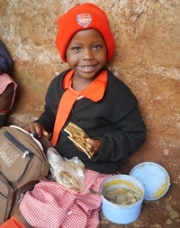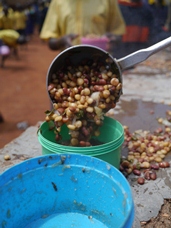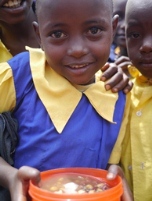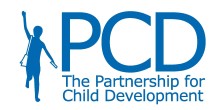 Background
Background
Background
 School feeding not only encourages children to get into school but it can also attract new enrolments from marginalised communities, if appropriately targeted on the basis of poverty and food insecurity. It can relieve short-term hunger and tackle micronutrient deficiencies, especially when combined with food fortification and deworming. There is emerging evidence that school feeding can contribute to the enhanced growth of young children, increasing the availability of food or financial resources in the household.
School feeding not only encourages children to get into school but it can also attract new enrolments from marginalised communities, if appropriately targeted on the basis of poverty and food insecurity. It can relieve short-term hunger and tackle micronutrient deficiencies, especially when combined with food fortification and deworming. There is emerging evidence that school feeding can contribute to the enhanced growth of young children, increasing the availability of food or financial resources in the household.
Not only does education provide a solid foundation for continued learning throughout life, but it is also critically important to children’s social integration and psychosocial well-being. School attendance helps children affected by trauma to regain a sense of normalcy and to recover from the impacts of their experiences and disrupted lives.
Extending the reach of school feeding to orphans and vulnerable children can provide a social safety net that helps address issues of inequity and gender imbalance. Keeping these children in school, especially girls, can reduce their vulnerability, including to HIV, and provide educational access of value such as through vocational training in agricultural practices, entrepreneurship and life skills education.
The Current Situation

Globally, an estimated 163 million children are orphaned, having lost one or both parents. Millions more are vulnerable due to the effects of illness and poverty. In the last three decades, the impact of the HIV pandemic has significantly contributed to the increase of orphans and other vulnerable children, a large proportion of who live in developing countries, in particular sub-Saharan Africa, and the majority of who are girls. 17.5 million children are estimated as having been orphaned by HIV and AIDS and over four-fifths (14.2 million) of these children live in sub-Saharan Africa alone.
Children with AIDS may also be at greater risk of contracting HIV sooner, experience stigma and discrimination, as well as the indirect effects of HIV on their community. Orphanhood, whether partial or full, negatively impacts upon outcomes for child development, social integration, health and education.
One tenth of the poorest children globally are least likely to attend school and are most likely to end up in a perpetuation of inter-generational cycles of poverty. Vulnerable children may forgo education for work or household duties, suffer from psychosocial problems and experience greater household poverty. Millions more are vulnerable due to the effects of illness and poverty. Without education, these populations miss the opportunity to acquire the skills to better their own lives.
Reaching Orphans and Vulnerable Children

Within the HGSF initiative, supporting sub-Saharan African Governments as well as stakeholders, (donors and implementing partners supporting national governments) is being undertaken in a transition towards seeing further HGSF OVC policy implementation.
This implementation aims for a more sustainable and multisectoral approach for the extension of school feeding to reach Orphans and Vulnerable Children (OVCs).
At the same time, the support, coordination, management and critical operational research priorities related to the OVC inclusion through HGSF is also being carried out. In this way, support to the most marginalized children will be catalysed, increasing their access to education whilst continuing to support long-term food security, as part of the overall HGSF vision.
Key Documents & Resources
- Promoting Quality Education for Orphans and Vulnerable Children - A Sourcebook
- Does the Provision of Food in School Increase Girls' Enrollment? Evidence from Rural Uganda
- Education and Vulnerability: the Role of Schools in Protecting Young Women and Girls from HIV in South Africa
- Keeping Adolescent Orphans in School to Prevent Human Immunodeficiency Virus Infection: Evidence From a Randomized Control Trial in Kenya
- World Bank Social Protection web page
The concept of orphans and vulnerable children (OVC) does not adhere to a universal definition and varies across countries in sub-Saharan Africa. The following definitions of a child, an orphan and of vulnerability have been adopted:
The child
Defined by the UN Convention on the Rights of the Child as “every human being below the age of eighteen years unless under the law applicable to the child, majority is attained earlier."
The orphan
The official definition of an orphan is a child aged zero to 17 years whose mother, father, or both have died (World Bank OVC Toolkit). There are, however, other children who are referred to as social orphans even though one or both their parents may still be alive but who have been unable to perform parental duties because of illness or acute poverty among other reasons.
Vulnerability
Vulnerability is viewed as "a high probability of a negative outcome" (World Bank OVC Toolkit), or an expected welfare loss above a socially accepted norm, which results from risky or uncertain events, and the lack of appropriate means to deal with them. Vulnerability leaves one at risk of exposure to stressful situations. The degree and type of vulnerability however, varies in each context and overtime.
Vulnerable child
A vulnerable child is defined as being under the age of 18 years and currently at high risk of lacking adequate care and protection. Accordingly, all children are vulnerable by nature compared to adults, but some are more critically vulnerable than others. “Child vulnerability is a downward spiral where each shock leads to a new level of vulnerability, and each new level opens up for a host of new risks. In other words, the probability of a child experiencing a negative outcome rises with each shock.” (World Bank OVC Toolkit)
Characteristics of children defined as vulnerable include those:
- orphaned by the death of one or both parents;
- abandoned by parents;
- living in extreme poverty;
- living with a disability;
- affected by armed conflicts;
- abused by parents or their carers;
- malnourished due to extreme poverty;
- HIV-positive;
- and finally, those marginalized, stigmatized, or even discriminated against.
All vulnerable children have one common denominator: they have no reliable social safety networks on hand to depend upon in order to adequately manage the risk to which they daily exposed.




